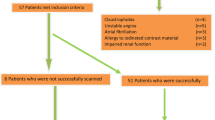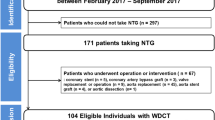Abstract
Purpose
The aim of this study was to validate a 64-row multidetector computed tomography (64-MDCT) acquisition protocol with biphasic administration of contrast medium for comprehensive assessment of the coronary and systemic arterial tree in a single examination.
Materials and methods
The scanning protocol comprised two acquisitions: an electrocardiograph (ECG)-gated scan at the level of the heart, followed by a total-body, low-dose scan of the systemic arterial circulation. Twenty patients were evaluated using two different strategies for contrast administration. In ten patients, the delay between the two acquisitions was set at 40 s, whereas in the remaining patients, it varied between 45 s and 65 s. For both strategies, the degree of systemic arterial opacification and the attenuation gradient between arterial and venous structures were quantitatively assessed at six extracoronary locations. Two observers evaluated in consensus the presence or absence of atherosclerosis and the degree of stenosis of arterial segments.
Results
Three hundred coronary segments were analysed. Arterial-wall changes were depicted in 155 (51%) segments, and in 35 (23%), the degree of stenosis was >50%. Of the 640 extracoronary arterial segments, 250 (39%) presented atherosclerotic wall alterations, in 50 (20%), the degree of stenosis was >50% and five were affected by aneurysmal dilatation. The magnitude of arterial opacification values and attenuation gradients between arterial and venous structures were significantly higher in patients scanned with the 40-s fixed-delay strategy.
Conclusions
Whole-body CT angiography with biphasic administration of contrast agent and fixed scan delay has been shown to be a feasible and reproducible technique. Comprehensive data on the global atherosclerotic burden potentially offer important therapeutic options for subclinical, high-risk segments.
Riassunto
Obiettivo
Ottimizzare un protocollo di scansione con somministrazione bifasica del mezzo di contrasto (MdC) per la valutazione angio-TC con scanner a 64 detettori delle arterie coronarie e del circolo arterioso sistemico in un unico esame.
Materiali e metodi
Il protocollo di scansione ha previsto una prima acquisizione con gating cardiaco per lo studio delle coronarie seguita da una scansione total-body a bassa dose per la vascolarizzazione sistemica, utilizzando due iniezioni di MdC. Sono stati esaminati 20 pazienti utilizzando due differenti strategie di ritardo (fisso: 40 s, o variabile: 45–65 s) tra prima e seconda somministrazione del MdC. Per entrambi i protocolli lo studio extracoronarico è stato valutato quantitativamente misurando il grado di opacizzazione arteriosa ed il gradiente di attenuazione delle strutture arteriose e venose a 6 differenti livelli. Due osservatori hanno valutato in consenso la presenza o assenza di patologia aterosclerotica ed il grado di stenosi dei segmenti arteriosi esaminati.
Risultati
Sono stati analizzati 300 segmenti coronarici, di cui 155 (51%) con alterazioni di parete; in 35 (23%) era presente una stenosi >50%. Dei 640 segmenti del circolo arterioso sistemico, 250 (39%) sono risultati patologici. In 50 (20%) era presente una stenosi compresa tra il 50% ed il 99%, in 5 era presente una dilatazione aneurismatica. I valori assoluti di opacizzazione arteriosa ed i gradienti di attenuazione tra struttture arteriose e venose del circolo extra-coronarico sono risultati significativamente più alti nei pazienti studiati con strategia di somministrazione a ritardo fisso rispetto a quelli evidenziati nei pazienti studiati con ritardo variabile.
Conclusioni
La tecnica angio-TC per lo studio del sistema arterioso di tutto il corpo con protocollo bifasico di somministrazione del MdC a ritardo fisso appare fattibile e riproducibile. Le numerose informazioni ottenibili sullo stato globale della patologia aterosclerotica offrono potenzialmente opzioni terapeutiche importanti soprattutto in distretti ad alto rischio, non ancora sintomatici.
Similar content being viewed by others
References/Bibliografia
Bhatt DL, Steg PG, Ohman EM et al (2006) International prevalence, recognition, and treatment of cardiovascular risk factors in outpatients with atherothrombosis. Jama 295:180–189
Lopez AD, Murray CC (1998) The global burden of disease, 1990–2020. Nat Med 4:1241–1243
Rosamond W, Flegal K, Friday G et al (2007) Heart disease and stroke statistics—2007 update: a report from the American Heart Association Statistics Committee and Stroke Statistics Subcommittee. Circulation 115:e69–e171
Lopez AD, Mathers CD, Ezzati M et al (2006) Global and regional burden of disease and risk factors, 2001: systematic analysis of population health data. Lancet 367:1747–1757
Jemal A, Ward E, Hao Y, Thun M (2005) Trends in the leading causes of death in the United States, 1970–2002. Jama 294:1255–1259
Celermajer DS (1998) Noninvasive detection of atherosclerosis. N Engl J Med 339:2014–2015
Fuster V, Fayad ZA, Moreno PR et al (2005) Atherothrombosis and high-risk plaque: Part II: approaches by noninvasive computed tomographic/magnetic resonance imaging. J Am Coll Cardiol 46:1209–1218
Fuster V (2005) The evolving role of CT and MRI in atherothrombotic evaluation and management. Nat Clin Pract Cardiovasc Med 2:323
Villablanca JP, Rodriguez FJ, Stockman T et al (2007) MDCT angiography for detection and quantification of small intracranial arteries: comparison with conventional catheter angiography. AJR Am J Roentgenol 188:593–602
Silvennoinen HM, Ikonen S, Soinne L et al (2007) CT angiographic analysis of carotid artery stenosis: comparison of manual assessment, semiautomatic vessel analysis, and digital subtraction angiography. AJNR Am J Neuroradiol 28:97–103
Vasbinder GB, Nelemans PJ, Kessels AG et al (2004) Accuracy of computed tomographic angiography and magnetic resonance angiography for diagnosing renal artery stenosis. Ann Intern Med 141:674–682
Rubin GD, Schmidt AJ, Logan LJ, Sofilos MC (2001) Multi-detector row CT angiography of lower extremity arterial inflow and runoff: initial experience. Radiology 221:146–158
Kock MC, Adriaensen ME, Pattynama PM et al (2005) DSA versus multidetector row CT angiography in peripheral arterial disease: randomized controlled trial. Radiology 237:727–737
Catalano C, Fraioli F, Laghi A et al (2004) Infrarenal aortic and lowerextremity arterial disease: diagnostic performance of multi-detector row CT angiography. Radiology 231:555–563
Garcia MJ, Lessick J, Hoffmann MH (2006) Accuracy of 16-row multidetector computed tomography for the assessment of coronary artery stenosis. Jama 296:403–411
de Feyter PJ, van Pelt N (2007) Spiral computed tomography coronary angiography: a new diagnostic tool developing its role in clinical cardiology. J Am Coll Cardiol 49:872–874
Dewey M, Teige F, Schnapauff D et al (2006) Noninvasive detection of coronary artery stenoses with multislice computed tomography or magnetic resonance imaging. Ann Intern Med 145:407–415
Hamon M, Biondi-Zoccai GG, Malagutti P et al (2006) Diagnostic performance of multislice spiral computed tomography of coronary arteries as compared with conventional invasive coronary angiography: a meta-analysis. J Am Coll Cardiol 48:1896–1910
Van Mieghem CA, Cademartiri F, Mollet NR et al (2006) Multislice spiral computed tomography for the evaluation of stent patency after left main coronary artery stenting: a comparison with conventional coronary angiography and intravascular ultrasound. Circulation 114:645–653
Leber AW, Knez A, Becker A et al (2004) Accuracy of multidetector spiral computed tomography in identifying and differentiating the composition of coronary atherosclerotic plaques: a comparative study with intracoronary ultrasound. J Am Coll Cardiol 43:1241–1247
Gaspar T, Halon DA, Lewis BS et al (2005) Diagnosis of coronary in-stent restenosis with multidetector row spiral computed tomography. J Am Coll Cardiol 46:1573–1579
Martuscelli E, Romagnoli A, D’Eliseo A et al (2004) Evaluation of venous and arterial conduit patency by 16-slice spiral computed tomography. Circulation 110:3234–3238
Meyer TS, Martinoff S, Hadamitzky M et al (2007) Improved noninvasive assessment of coronary artery bypass grafts with 64-slice computed tomographic angiography in an unselected patient population. J Am Coll Cardiol 49:946–950
Ehara M, Kawai M, Surmely JF et al (2007) Diagnostic accuracy of coronary in-stent restenosis using 64-slice computed tomography: comparison with invasive coronary angiography. J Am Coll Cardiol 49:951–959
Leber AW, Becker A, Knez A et al (2006) Accuracy of 64-slice computed tomography to classify and quantify plaque volumes in the proximal coronary system: a comparative study using intravascular ultrasound. J Am Coll Cardiol 47:672–677
Nikolaou K, Knez A, Rist C et al (2006) Accuracy of 64-MDCT in the diagnosis of ischemic heart disease. AJR Am J Roentgenol 187:111–117
Oncel D, Oncel G, Karaca M (2007) Coronary stent patency and in-stent restenosis: determination with 64-section multidetector CT coronary angiography—initial experience. Radiology 242:403–409
Ropers D, Pohle FK, Kuettner A et al (2006) Diagnostic accuracy of noninvasive coronary angiography in patients after bypass surgery using 64-slice spiral computed tomography with 330-ms gantry rotation. Circulation 114:2334–2341
Rubinshtein R, Halon DA, Gaspar T et al (2007) Usefulness of 64-slice cardiac computed tomographic angiography for diagnosing acute coronary syndromes and predicting clinical outcome in emergency department patients with chest pain of uncertain origin. Circulation 115:1762–1768
Yamamuro M, Tadamura E, Kanao S et al (2007) Coronary Angiography by 64-Detector Row Computed Tomography Using Low Dose of Contrast Material with Saline Chaser: Influence of Total Injection Volume on Vessel Attenuation. J Comput Assist Tomogr 31:272–280
Austen WG, Edwards JE, Frye RL et al (1975) A reporting system on patients evaluated for coronary artery disease. Report of the Ad Hoc Committee for Grading of Coronary Artery Disease, Council on Cardiovascular Surgery, American Heart Association. Circulation 51:5–40
Bae KT (2003) Peak contrast enhancement in CT and MR angiography: when does it occur and why? Pharmacokinetic study in a porcine model. Radiology 227:809–816
Fleischmann D, Rubin GD, Bankier AA, Hittmair K (2000) Improved uniformity of aortic enhancement with customized contrast medium injection protocols at CT angiography. Radiology 214:363–371
Steg PG, Bhatt DL, Wilson PW et al (2007) One-year cardiovascular event rates in outpatients with atherothrombosis. Jama 297:1197–1206
Author information
Authors and Affiliations
Corresponding author
Rights and permissions
About this article
Cite this article
Napoli, A., Anzidei, M., Francone, M. et al. 64-MDCT imaging of the coronary arteries and systemic arterial vascular tree in a single examination: optimisation of the scan protocol and contrast-agent administration. Radiol med 113, 799–816 (2008). https://doi.org/10.1007/s11547-008-0304-3
Received:
Accepted:
Published:
Issue Date:
DOI: https://doi.org/10.1007/s11547-008-0304-3




